Analysis of Global Tourism and Hospitality Futures and Trends
VerifiedAdded on 2023/06/07
|11
|2567
|286
Report
AI Summary
This report delves into the dynamic landscape of global tourism and hospitality, focusing on emerging trends and their implications for the industry, particularly in the context of Australia. It analyzes the increasing prominence of Asian tourism destinations, identifying key drivers such as rich cultural heritage, heritage sites, and favorable climates. The report further examines the correlation between political, socio-cultural, and economic factors and their influence on tourism. It provides strategic recommendations for the marketing and management of tourism, including collaborations, effective promotion, and cost-effective services. The report explores the relationship between tourism and content areas such as media, commodity culture, and visual culture, concluding with a discussion on the future trajectory of the tourism industry. The report emphasizes the need for proactive strategies to adapt to the evolving trends and ensure sustained success and competitiveness in the global tourism market.
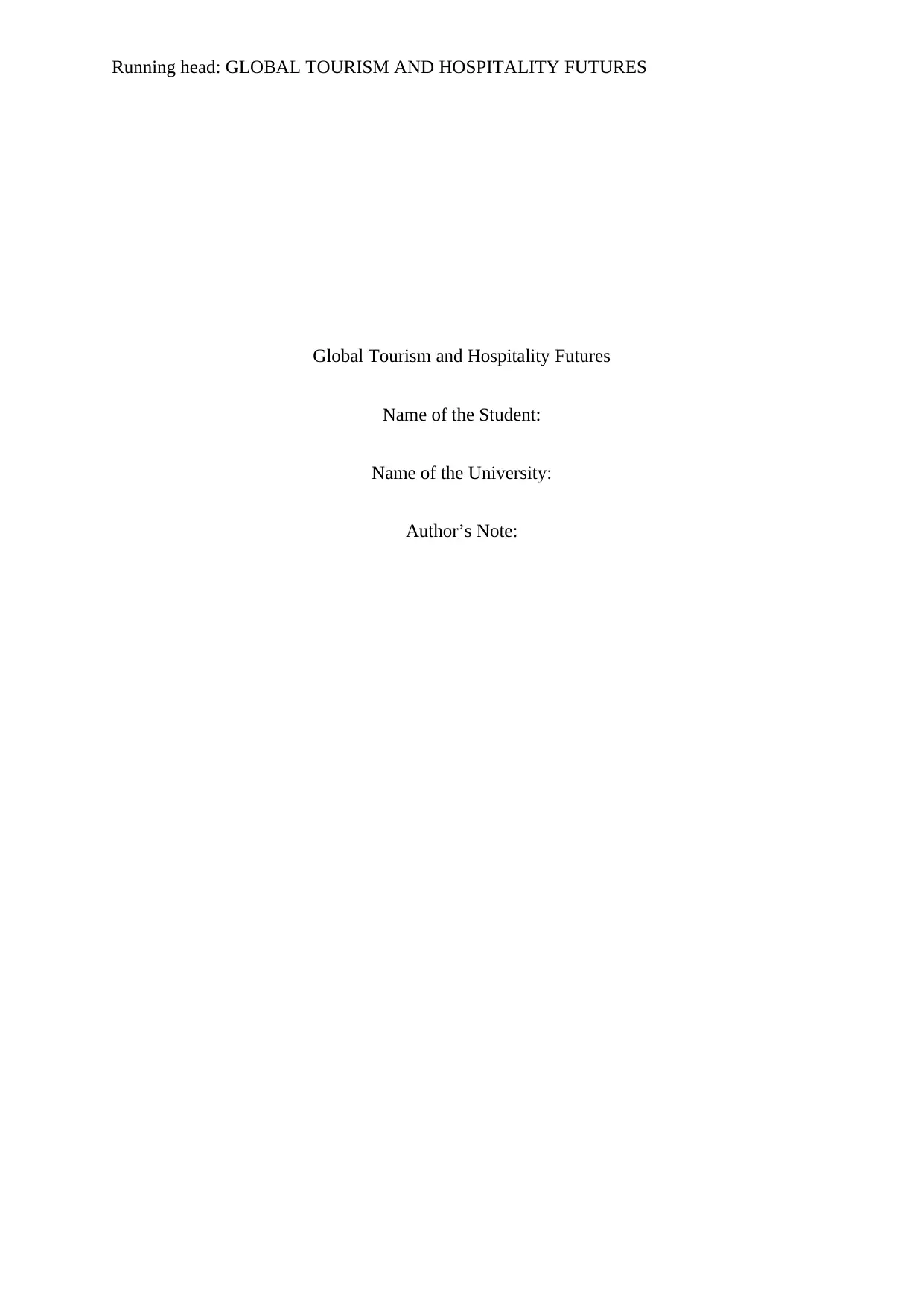
Running head: GLOBAL TOURISM AND HOSPITALITY FUTURES
Global Tourism and Hospitality Futures
Name of the Student:
Name of the University:
Author’s Note:
Global Tourism and Hospitality Futures
Name of the Student:
Name of the University:
Author’s Note:
Paraphrase This Document
Need a fresh take? Get an instant paraphrase of this document with our AI Paraphraser
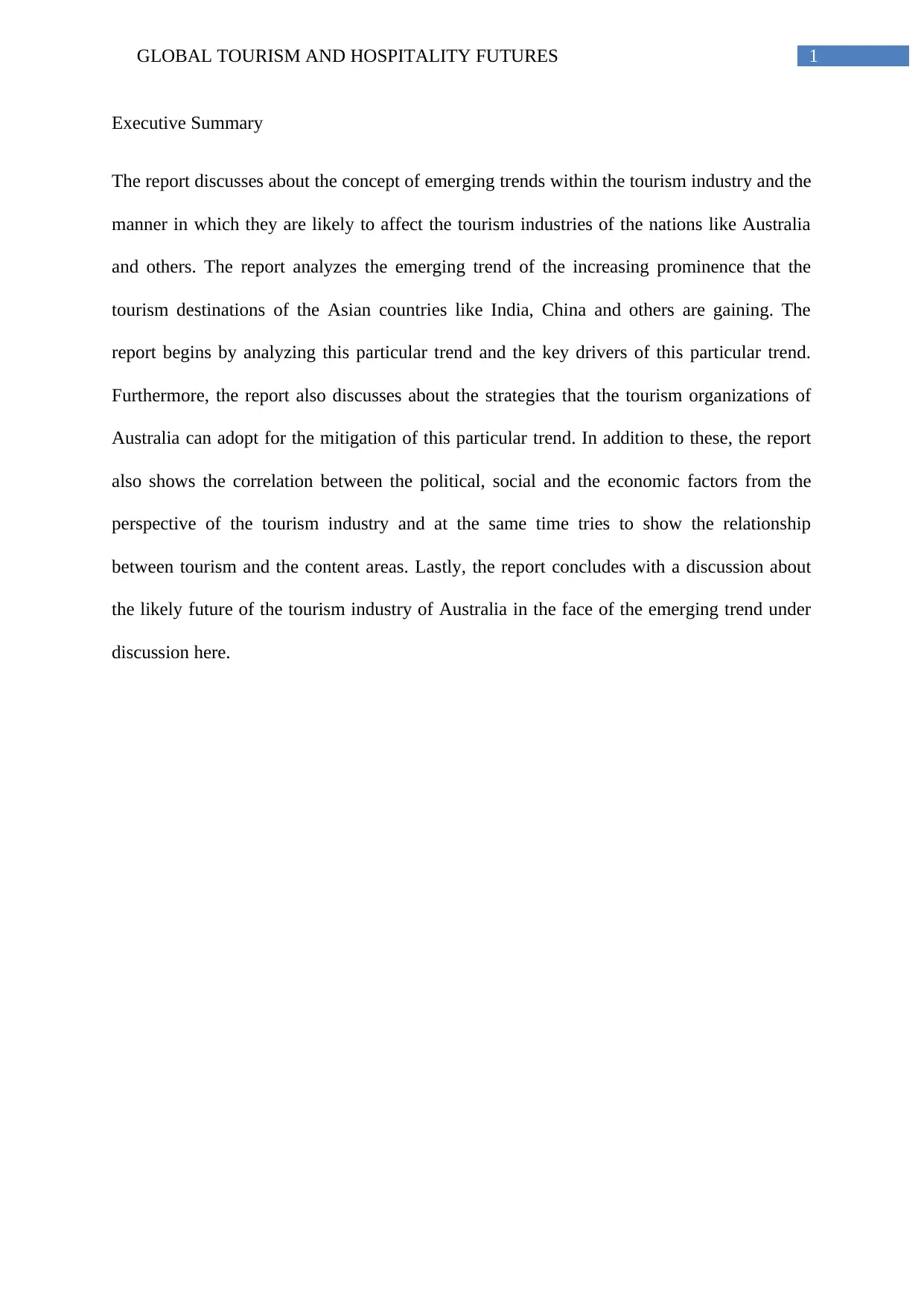
1GLOBAL TOURISM AND HOSPITALITY FUTURES
Executive Summary
The report discusses about the concept of emerging trends within the tourism industry and the
manner in which they are likely to affect the tourism industries of the nations like Australia
and others. The report analyzes the emerging trend of the increasing prominence that the
tourism destinations of the Asian countries like India, China and others are gaining. The
report begins by analyzing this particular trend and the key drivers of this particular trend.
Furthermore, the report also discusses about the strategies that the tourism organizations of
Australia can adopt for the mitigation of this particular trend. In addition to these, the report
also shows the correlation between the political, social and the economic factors from the
perspective of the tourism industry and at the same time tries to show the relationship
between tourism and the content areas. Lastly, the report concludes with a discussion about
the likely future of the tourism industry of Australia in the face of the emerging trend under
discussion here.
Executive Summary
The report discusses about the concept of emerging trends within the tourism industry and the
manner in which they are likely to affect the tourism industries of the nations like Australia
and others. The report analyzes the emerging trend of the increasing prominence that the
tourism destinations of the Asian countries like India, China and others are gaining. The
report begins by analyzing this particular trend and the key drivers of this particular trend.
Furthermore, the report also discusses about the strategies that the tourism organizations of
Australia can adopt for the mitigation of this particular trend. In addition to these, the report
also shows the correlation between the political, social and the economic factors from the
perspective of the tourism industry and at the same time tries to show the relationship
between tourism and the content areas. Lastly, the report concludes with a discussion about
the likely future of the tourism industry of Australia in the face of the emerging trend under
discussion here.
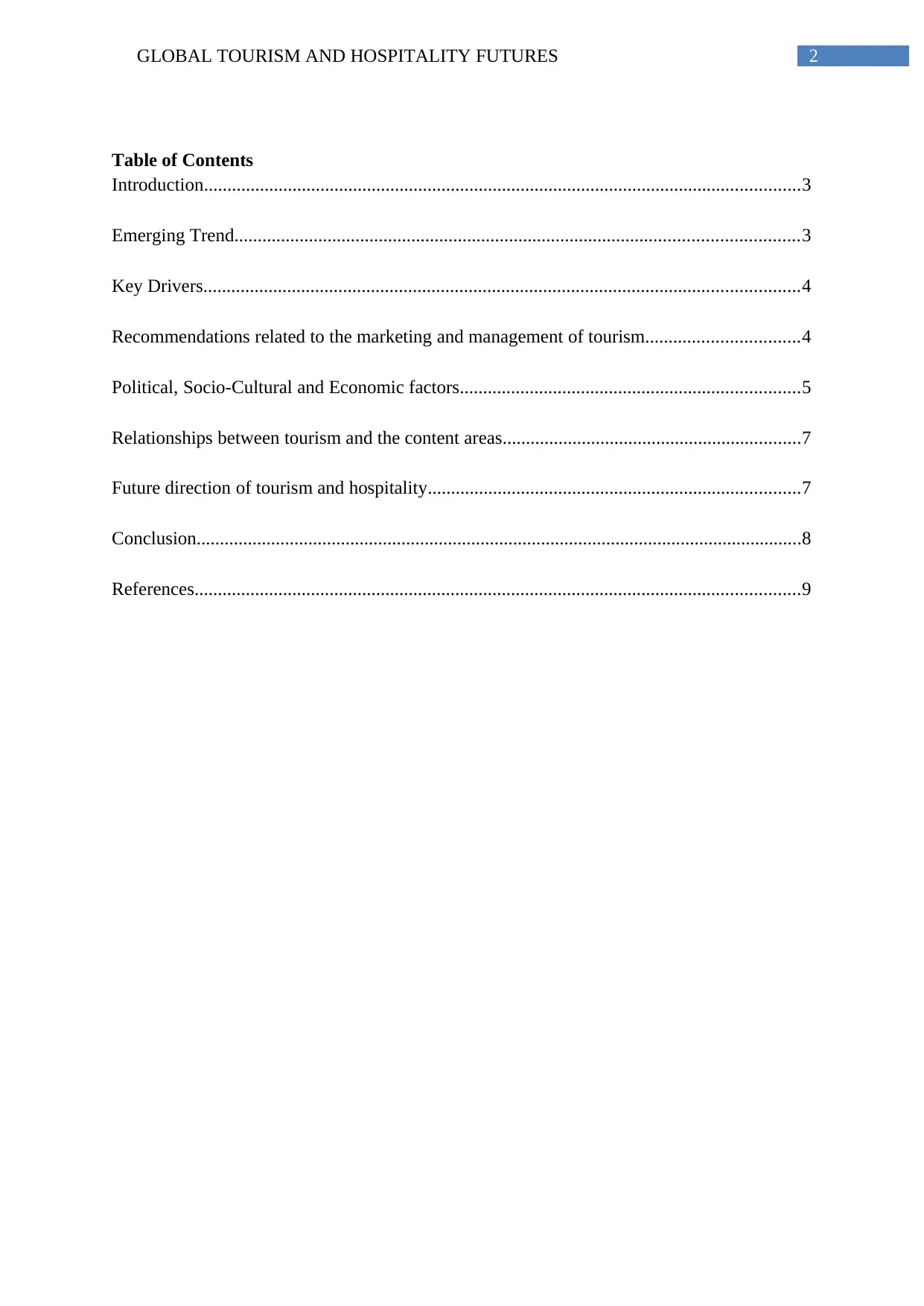
2GLOBAL TOURISM AND HOSPITALITY FUTURES
Table of Contents
Introduction................................................................................................................................3
Emerging Trend.........................................................................................................................3
Key Drivers................................................................................................................................4
Recommendations related to the marketing and management of tourism.................................4
Political, Socio-Cultural and Economic factors.........................................................................5
Relationships between tourism and the content areas................................................................7
Future direction of tourism and hospitality................................................................................7
Conclusion..................................................................................................................................8
References..................................................................................................................................9
Table of Contents
Introduction................................................................................................................................3
Emerging Trend.........................................................................................................................3
Key Drivers................................................................................................................................4
Recommendations related to the marketing and management of tourism.................................4
Political, Socio-Cultural and Economic factors.........................................................................5
Relationships between tourism and the content areas................................................................7
Future direction of tourism and hospitality................................................................................7
Conclusion..................................................................................................................................8
References..................................................................................................................................9
⊘ This is a preview!⊘
Do you want full access?
Subscribe today to unlock all pages.

Trusted by 1+ million students worldwide
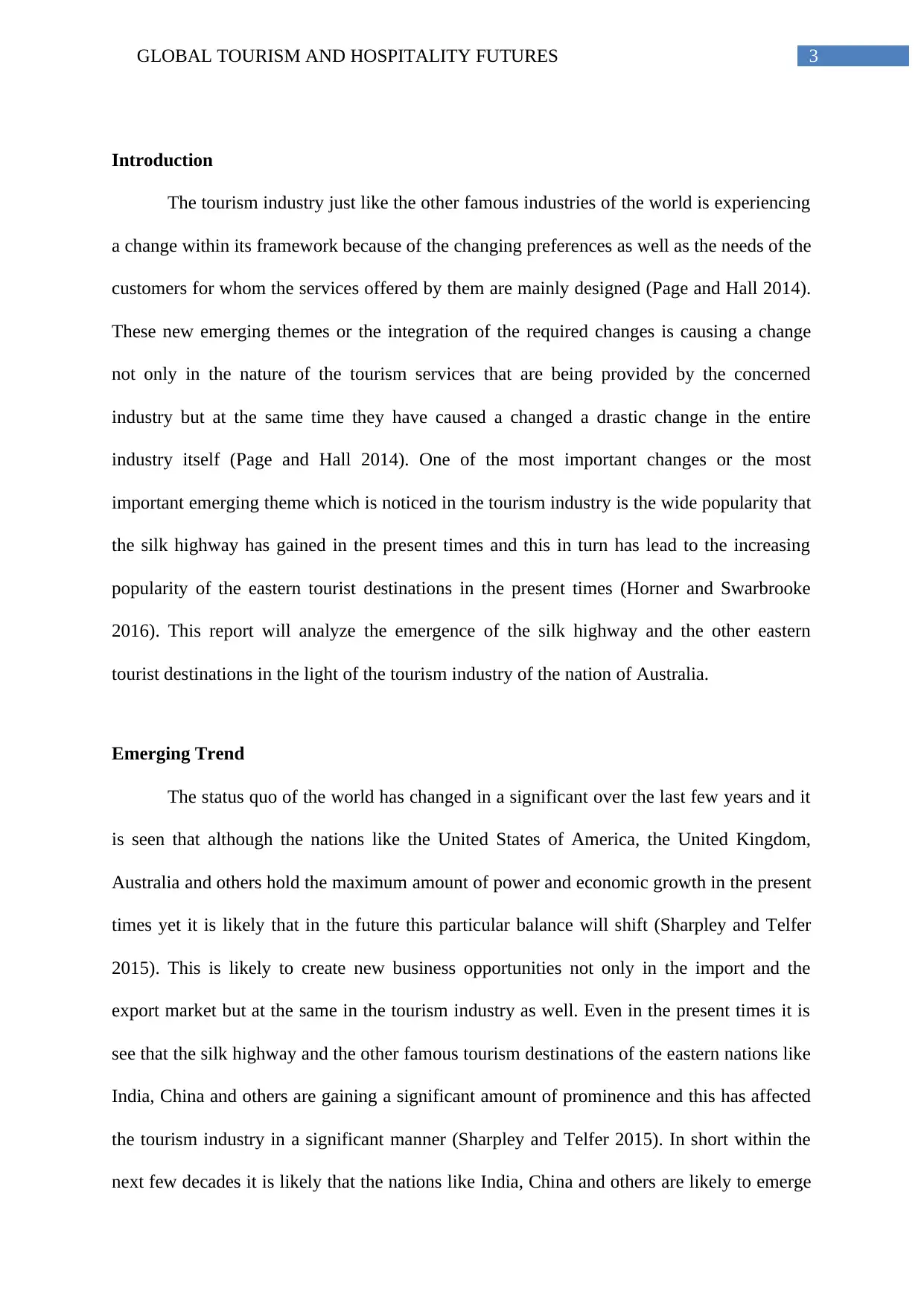
3GLOBAL TOURISM AND HOSPITALITY FUTURES
Introduction
The tourism industry just like the other famous industries of the world is experiencing
a change within its framework because of the changing preferences as well as the needs of the
customers for whom the services offered by them are mainly designed (Page and Hall 2014).
These new emerging themes or the integration of the required changes is causing a change
not only in the nature of the tourism services that are being provided by the concerned
industry but at the same time they have caused a changed a drastic change in the entire
industry itself (Page and Hall 2014). One of the most important changes or the most
important emerging theme which is noticed in the tourism industry is the wide popularity that
the silk highway has gained in the present times and this in turn has lead to the increasing
popularity of the eastern tourist destinations in the present times (Horner and Swarbrooke
2016). This report will analyze the emergence of the silk highway and the other eastern
tourist destinations in the light of the tourism industry of the nation of Australia.
Emerging Trend
The status quo of the world has changed in a significant over the last few years and it
is seen that although the nations like the United States of America, the United Kingdom,
Australia and others hold the maximum amount of power and economic growth in the present
times yet it is likely that in the future this particular balance will shift (Sharpley and Telfer
2015). This is likely to create new business opportunities not only in the import and the
export market but at the same in the tourism industry as well. Even in the present times it is
see that the silk highway and the other famous tourism destinations of the eastern nations like
India, China and others are gaining a significant amount of prominence and this has affected
the tourism industry in a significant manner (Sharpley and Telfer 2015). In short within the
next few decades it is likely that the nations like India, China and others are likely to emerge
Introduction
The tourism industry just like the other famous industries of the world is experiencing
a change within its framework because of the changing preferences as well as the needs of the
customers for whom the services offered by them are mainly designed (Page and Hall 2014).
These new emerging themes or the integration of the required changes is causing a change
not only in the nature of the tourism services that are being provided by the concerned
industry but at the same time they have caused a changed a drastic change in the entire
industry itself (Page and Hall 2014). One of the most important changes or the most
important emerging theme which is noticed in the tourism industry is the wide popularity that
the silk highway has gained in the present times and this in turn has lead to the increasing
popularity of the eastern tourist destinations in the present times (Horner and Swarbrooke
2016). This report will analyze the emergence of the silk highway and the other eastern
tourist destinations in the light of the tourism industry of the nation of Australia.
Emerging Trend
The status quo of the world has changed in a significant over the last few years and it
is seen that although the nations like the United States of America, the United Kingdom,
Australia and others hold the maximum amount of power and economic growth in the present
times yet it is likely that in the future this particular balance will shift (Sharpley and Telfer
2015). This is likely to create new business opportunities not only in the import and the
export market but at the same in the tourism industry as well. Even in the present times it is
see that the silk highway and the other famous tourism destinations of the eastern nations like
India, China and others are gaining a significant amount of prominence and this has affected
the tourism industry in a significant manner (Sharpley and Telfer 2015). In short within the
next few decades it is likely that the nations like India, China and others are likely to emerge
Paraphrase This Document
Need a fresh take? Get an instant paraphrase of this document with our AI Paraphraser
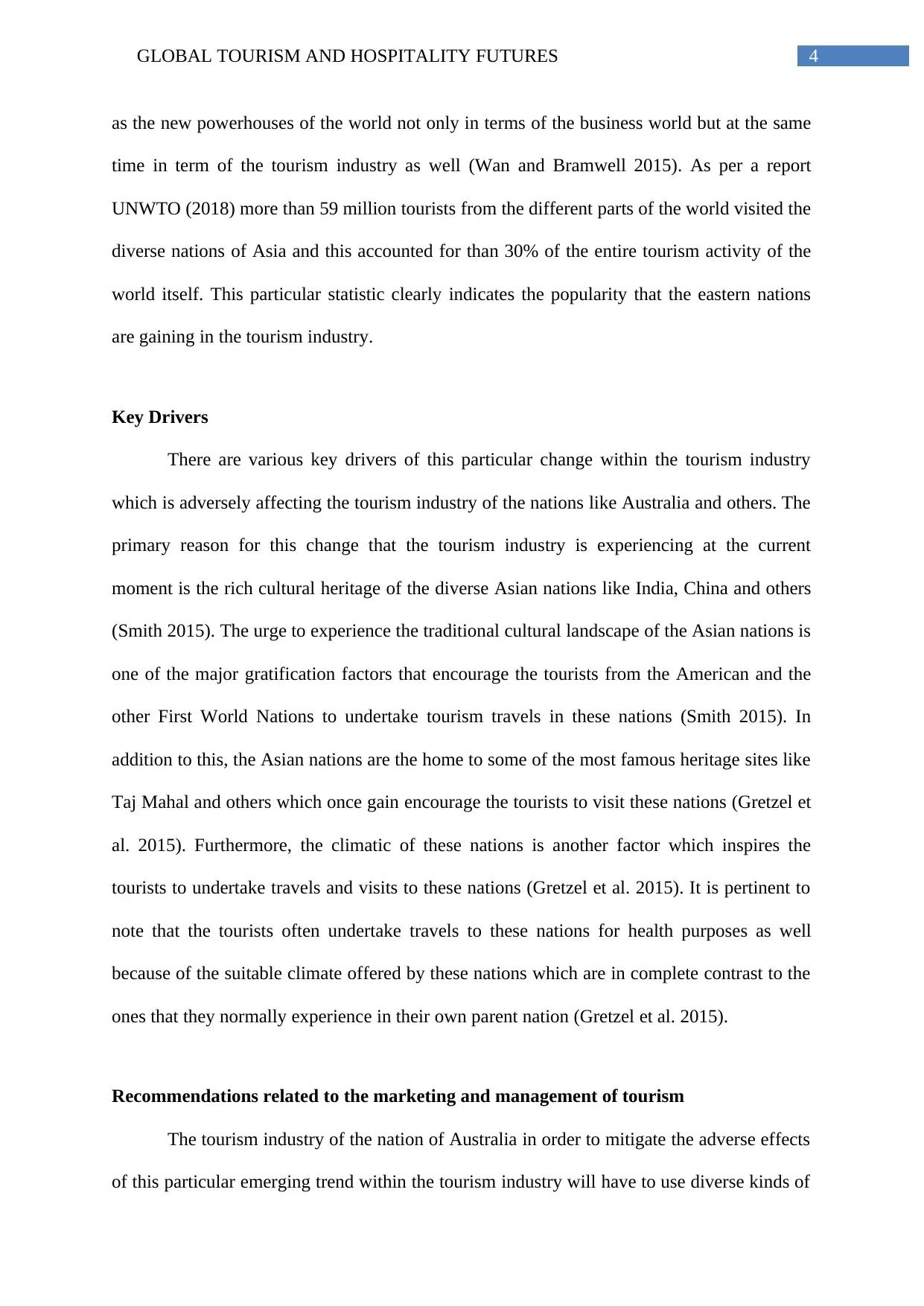
4GLOBAL TOURISM AND HOSPITALITY FUTURES
as the new powerhouses of the world not only in terms of the business world but at the same
time in term of the tourism industry as well (Wan and Bramwell 2015). As per a report
UNWTO (2018) more than 59 million tourists from the different parts of the world visited the
diverse nations of Asia and this accounted for than 30% of the entire tourism activity of the
world itself. This particular statistic clearly indicates the popularity that the eastern nations
are gaining in the tourism industry.
Key Drivers
There are various key drivers of this particular change within the tourism industry
which is adversely affecting the tourism industry of the nations like Australia and others. The
primary reason for this change that the tourism industry is experiencing at the current
moment is the rich cultural heritage of the diverse Asian nations like India, China and others
(Smith 2015). The urge to experience the traditional cultural landscape of the Asian nations is
one of the major gratification factors that encourage the tourists from the American and the
other First World Nations to undertake tourism travels in these nations (Smith 2015). In
addition to this, the Asian nations are the home to some of the most famous heritage sites like
Taj Mahal and others which once gain encourage the tourists to visit these nations (Gretzel et
al. 2015). Furthermore, the climatic of these nations is another factor which inspires the
tourists to undertake travels and visits to these nations (Gretzel et al. 2015). It is pertinent to
note that the tourists often undertake travels to these nations for health purposes as well
because of the suitable climate offered by these nations which are in complete contrast to the
ones that they normally experience in their own parent nation (Gretzel et al. 2015).
Recommendations related to the marketing and management of tourism
The tourism industry of the nation of Australia in order to mitigate the adverse effects
of this particular emerging trend within the tourism industry will have to use diverse kinds of
as the new powerhouses of the world not only in terms of the business world but at the same
time in term of the tourism industry as well (Wan and Bramwell 2015). As per a report
UNWTO (2018) more than 59 million tourists from the different parts of the world visited the
diverse nations of Asia and this accounted for than 30% of the entire tourism activity of the
world itself. This particular statistic clearly indicates the popularity that the eastern nations
are gaining in the tourism industry.
Key Drivers
There are various key drivers of this particular change within the tourism industry
which is adversely affecting the tourism industry of the nations like Australia and others. The
primary reason for this change that the tourism industry is experiencing at the current
moment is the rich cultural heritage of the diverse Asian nations like India, China and others
(Smith 2015). The urge to experience the traditional cultural landscape of the Asian nations is
one of the major gratification factors that encourage the tourists from the American and the
other First World Nations to undertake tourism travels in these nations (Smith 2015). In
addition to this, the Asian nations are the home to some of the most famous heritage sites like
Taj Mahal and others which once gain encourage the tourists to visit these nations (Gretzel et
al. 2015). Furthermore, the climatic of these nations is another factor which inspires the
tourists to undertake travels and visits to these nations (Gretzel et al. 2015). It is pertinent to
note that the tourists often undertake travels to these nations for health purposes as well
because of the suitable climate offered by these nations which are in complete contrast to the
ones that they normally experience in their own parent nation (Gretzel et al. 2015).
Recommendations related to the marketing and management of tourism
The tourism industry of the nation of Australia in order to mitigate the adverse effects
of this particular emerging trend within the tourism industry will have to use diverse kinds of
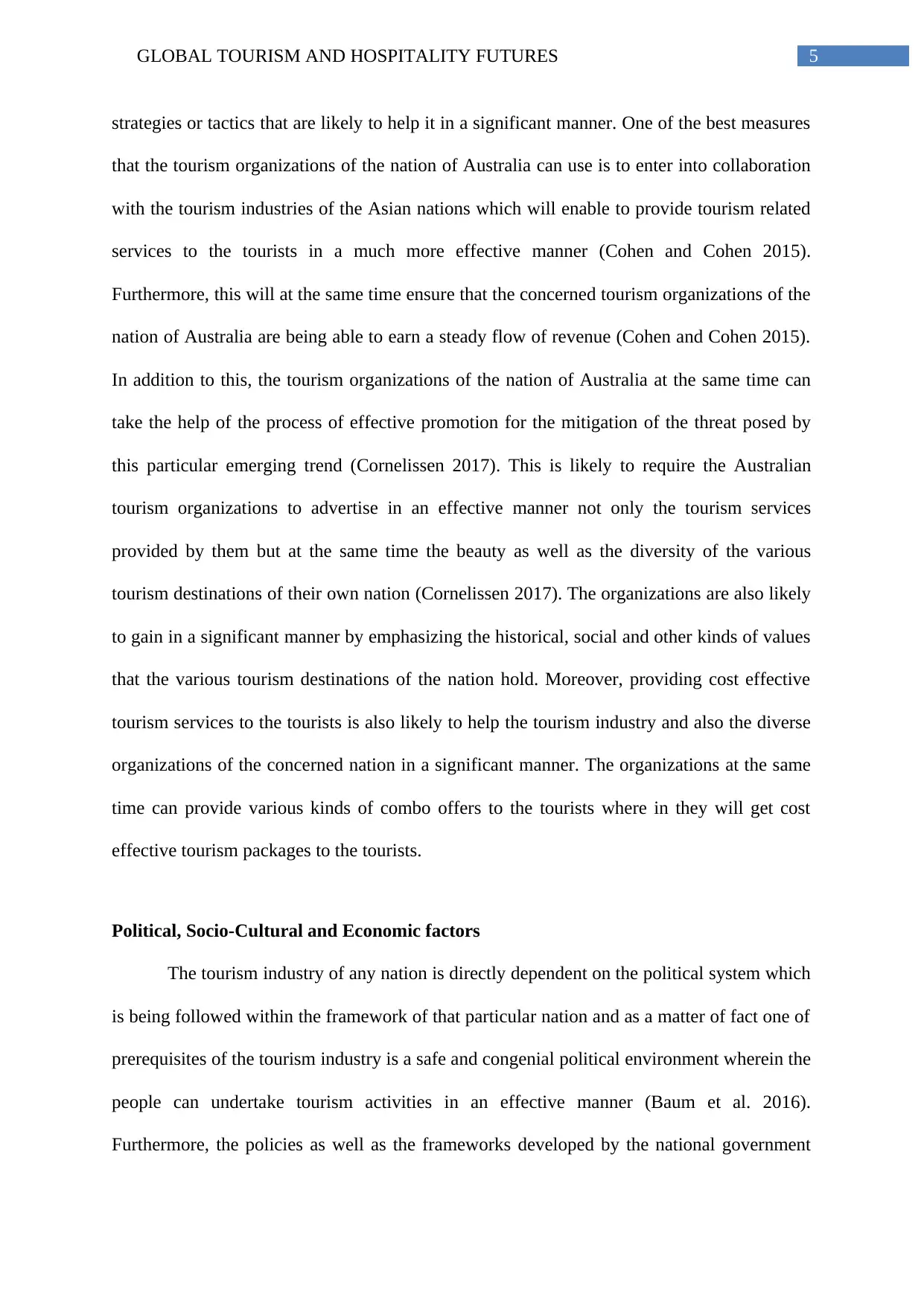
5GLOBAL TOURISM AND HOSPITALITY FUTURES
strategies or tactics that are likely to help it in a significant manner. One of the best measures
that the tourism organizations of the nation of Australia can use is to enter into collaboration
with the tourism industries of the Asian nations which will enable to provide tourism related
services to the tourists in a much more effective manner (Cohen and Cohen 2015).
Furthermore, this will at the same time ensure that the concerned tourism organizations of the
nation of Australia are being able to earn a steady flow of revenue (Cohen and Cohen 2015).
In addition to this, the tourism organizations of the nation of Australia at the same time can
take the help of the process of effective promotion for the mitigation of the threat posed by
this particular emerging trend (Cornelissen 2017). This is likely to require the Australian
tourism organizations to advertise in an effective manner not only the tourism services
provided by them but at the same time the beauty as well as the diversity of the various
tourism destinations of their own nation (Cornelissen 2017). The organizations are also likely
to gain in a significant manner by emphasizing the historical, social and other kinds of values
that the various tourism destinations of the nation hold. Moreover, providing cost effective
tourism services to the tourists is also likely to help the tourism industry and also the diverse
organizations of the concerned nation in a significant manner. The organizations at the same
time can provide various kinds of combo offers to the tourists where in they will get cost
effective tourism packages to the tourists.
Political, Socio-Cultural and Economic factors
The tourism industry of any nation is directly dependent on the political system which
is being followed within the framework of that particular nation and as a matter of fact one of
prerequisites of the tourism industry is a safe and congenial political environment wherein the
people can undertake tourism activities in an effective manner (Baum et al. 2016).
Furthermore, the policies as well as the frameworks developed by the national government
strategies or tactics that are likely to help it in a significant manner. One of the best measures
that the tourism organizations of the nation of Australia can use is to enter into collaboration
with the tourism industries of the Asian nations which will enable to provide tourism related
services to the tourists in a much more effective manner (Cohen and Cohen 2015).
Furthermore, this will at the same time ensure that the concerned tourism organizations of the
nation of Australia are being able to earn a steady flow of revenue (Cohen and Cohen 2015).
In addition to this, the tourism organizations of the nation of Australia at the same time can
take the help of the process of effective promotion for the mitigation of the threat posed by
this particular emerging trend (Cornelissen 2017). This is likely to require the Australian
tourism organizations to advertise in an effective manner not only the tourism services
provided by them but at the same time the beauty as well as the diversity of the various
tourism destinations of their own nation (Cornelissen 2017). The organizations are also likely
to gain in a significant manner by emphasizing the historical, social and other kinds of values
that the various tourism destinations of the nation hold. Moreover, providing cost effective
tourism services to the tourists is also likely to help the tourism industry and also the diverse
organizations of the concerned nation in a significant manner. The organizations at the same
time can provide various kinds of combo offers to the tourists where in they will get cost
effective tourism packages to the tourists.
Political, Socio-Cultural and Economic factors
The tourism industry of any nation is directly dependent on the political system which
is being followed within the framework of that particular nation and as a matter of fact one of
prerequisites of the tourism industry is a safe and congenial political environment wherein the
people can undertake tourism activities in an effective manner (Baum et al. 2016).
Furthermore, the policies as well as the frameworks developed by the national government
⊘ This is a preview!⊘
Do you want full access?
Subscribe today to unlock all pages.

Trusted by 1+ million students worldwide
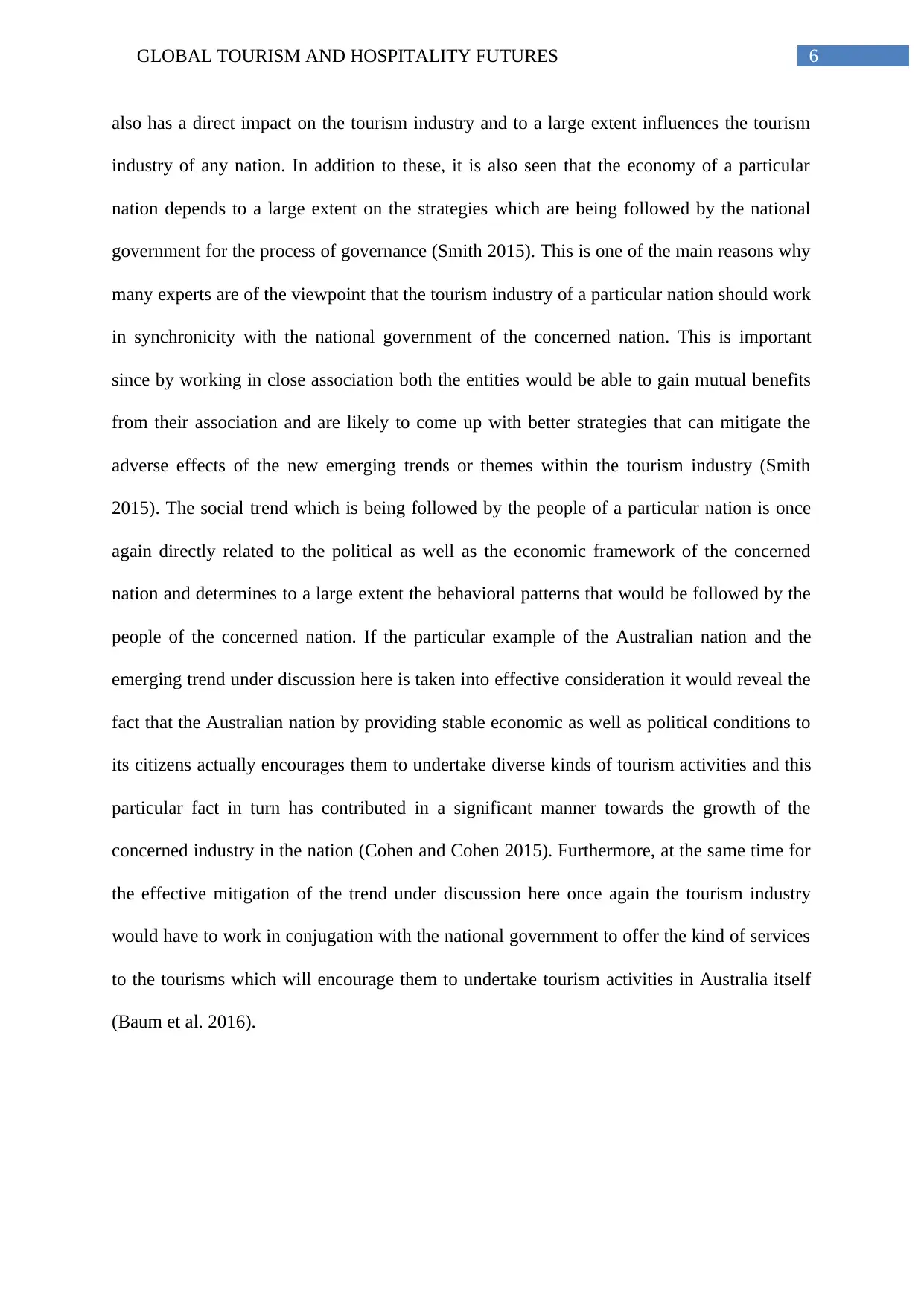
6GLOBAL TOURISM AND HOSPITALITY FUTURES
also has a direct impact on the tourism industry and to a large extent influences the tourism
industry of any nation. In addition to these, it is also seen that the economy of a particular
nation depends to a large extent on the strategies which are being followed by the national
government for the process of governance (Smith 2015). This is one of the main reasons why
many experts are of the viewpoint that the tourism industry of a particular nation should work
in synchronicity with the national government of the concerned nation. This is important
since by working in close association both the entities would be able to gain mutual benefits
from their association and are likely to come up with better strategies that can mitigate the
adverse effects of the new emerging trends or themes within the tourism industry (Smith
2015). The social trend which is being followed by the people of a particular nation is once
again directly related to the political as well as the economic framework of the concerned
nation and determines to a large extent the behavioral patterns that would be followed by the
people of the concerned nation. If the particular example of the Australian nation and the
emerging trend under discussion here is taken into effective consideration it would reveal the
fact that the Australian nation by providing stable economic as well as political conditions to
its citizens actually encourages them to undertake diverse kinds of tourism activities and this
particular fact in turn has contributed in a significant manner towards the growth of the
concerned industry in the nation (Cohen and Cohen 2015). Furthermore, at the same time for
the effective mitigation of the trend under discussion here once again the tourism industry
would have to work in conjugation with the national government to offer the kind of services
to the tourisms which will encourage them to undertake tourism activities in Australia itself
(Baum et al. 2016).
also has a direct impact on the tourism industry and to a large extent influences the tourism
industry of any nation. In addition to these, it is also seen that the economy of a particular
nation depends to a large extent on the strategies which are being followed by the national
government for the process of governance (Smith 2015). This is one of the main reasons why
many experts are of the viewpoint that the tourism industry of a particular nation should work
in synchronicity with the national government of the concerned nation. This is important
since by working in close association both the entities would be able to gain mutual benefits
from their association and are likely to come up with better strategies that can mitigate the
adverse effects of the new emerging trends or themes within the tourism industry (Smith
2015). The social trend which is being followed by the people of a particular nation is once
again directly related to the political as well as the economic framework of the concerned
nation and determines to a large extent the behavioral patterns that would be followed by the
people of the concerned nation. If the particular example of the Australian nation and the
emerging trend under discussion here is taken into effective consideration it would reveal the
fact that the Australian nation by providing stable economic as well as political conditions to
its citizens actually encourages them to undertake diverse kinds of tourism activities and this
particular fact in turn has contributed in a significant manner towards the growth of the
concerned industry in the nation (Cohen and Cohen 2015). Furthermore, at the same time for
the effective mitigation of the trend under discussion here once again the tourism industry
would have to work in conjugation with the national government to offer the kind of services
to the tourisms which will encourage them to undertake tourism activities in Australia itself
(Baum et al. 2016).
Paraphrase This Document
Need a fresh take? Get an instant paraphrase of this document with our AI Paraphraser
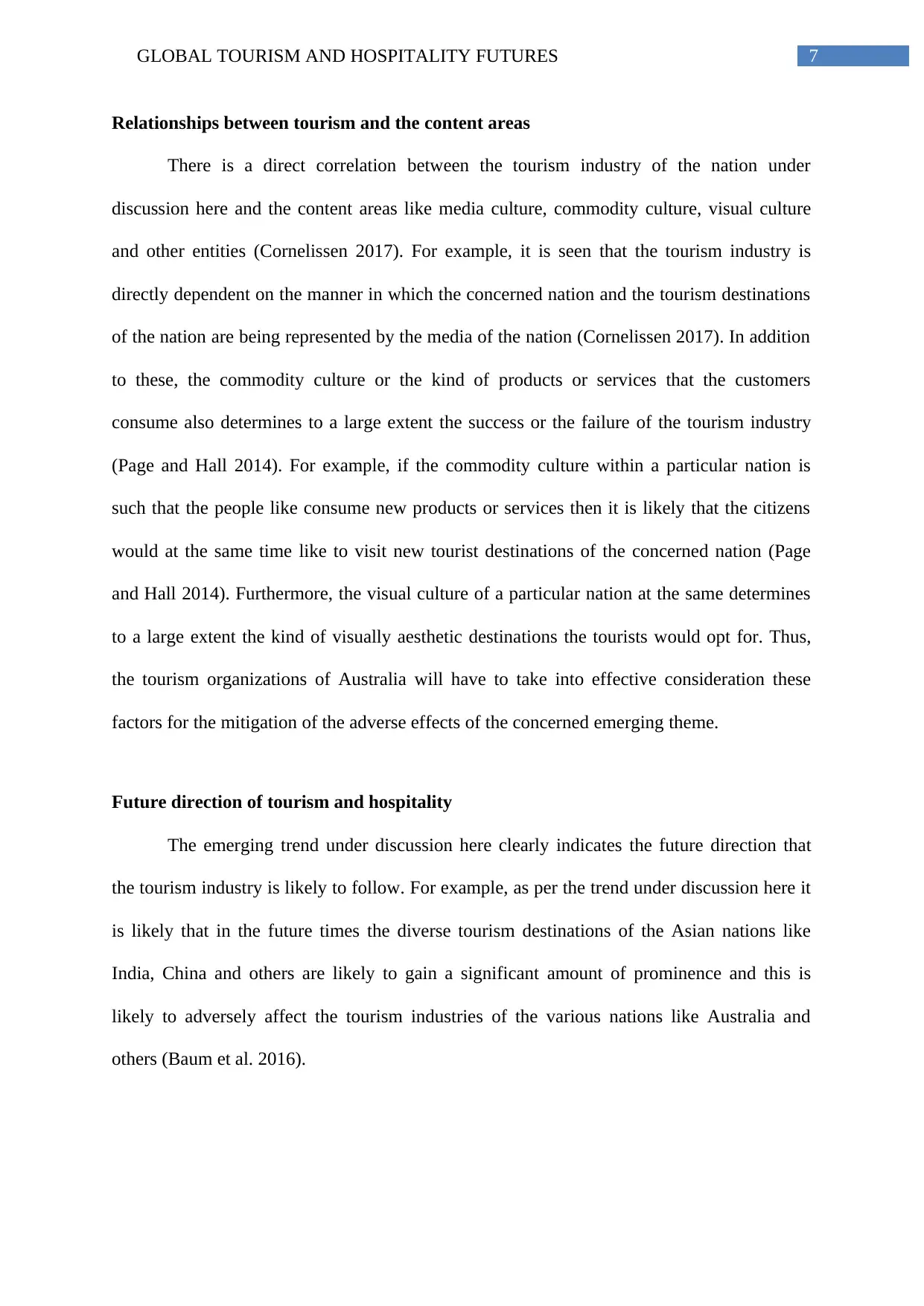
7GLOBAL TOURISM AND HOSPITALITY FUTURES
Relationships between tourism and the content areas
There is a direct correlation between the tourism industry of the nation under
discussion here and the content areas like media culture, commodity culture, visual culture
and other entities (Cornelissen 2017). For example, it is seen that the tourism industry is
directly dependent on the manner in which the concerned nation and the tourism destinations
of the nation are being represented by the media of the nation (Cornelissen 2017). In addition
to these, the commodity culture or the kind of products or services that the customers
consume also determines to a large extent the success or the failure of the tourism industry
(Page and Hall 2014). For example, if the commodity culture within a particular nation is
such that the people like consume new products or services then it is likely that the citizens
would at the same time like to visit new tourist destinations of the concerned nation (Page
and Hall 2014). Furthermore, the visual culture of a particular nation at the same determines
to a large extent the kind of visually aesthetic destinations the tourists would opt for. Thus,
the tourism organizations of Australia will have to take into effective consideration these
factors for the mitigation of the adverse effects of the concerned emerging theme.
Future direction of tourism and hospitality
The emerging trend under discussion here clearly indicates the future direction that
the tourism industry is likely to follow. For example, as per the trend under discussion here it
is likely that in the future times the diverse tourism destinations of the Asian nations like
India, China and others are likely to gain a significant amount of prominence and this is
likely to adversely affect the tourism industries of the various nations like Australia and
others (Baum et al. 2016).
Relationships between tourism and the content areas
There is a direct correlation between the tourism industry of the nation under
discussion here and the content areas like media culture, commodity culture, visual culture
and other entities (Cornelissen 2017). For example, it is seen that the tourism industry is
directly dependent on the manner in which the concerned nation and the tourism destinations
of the nation are being represented by the media of the nation (Cornelissen 2017). In addition
to these, the commodity culture or the kind of products or services that the customers
consume also determines to a large extent the success or the failure of the tourism industry
(Page and Hall 2014). For example, if the commodity culture within a particular nation is
such that the people like consume new products or services then it is likely that the citizens
would at the same time like to visit new tourist destinations of the concerned nation (Page
and Hall 2014). Furthermore, the visual culture of a particular nation at the same determines
to a large extent the kind of visually aesthetic destinations the tourists would opt for. Thus,
the tourism organizations of Australia will have to take into effective consideration these
factors for the mitigation of the adverse effects of the concerned emerging theme.
Future direction of tourism and hospitality
The emerging trend under discussion here clearly indicates the future direction that
the tourism industry is likely to follow. For example, as per the trend under discussion here it
is likely that in the future times the diverse tourism destinations of the Asian nations like
India, China and others are likely to gain a significant amount of prominence and this is
likely to adversely affect the tourism industries of the various nations like Australia and
others (Baum et al. 2016).
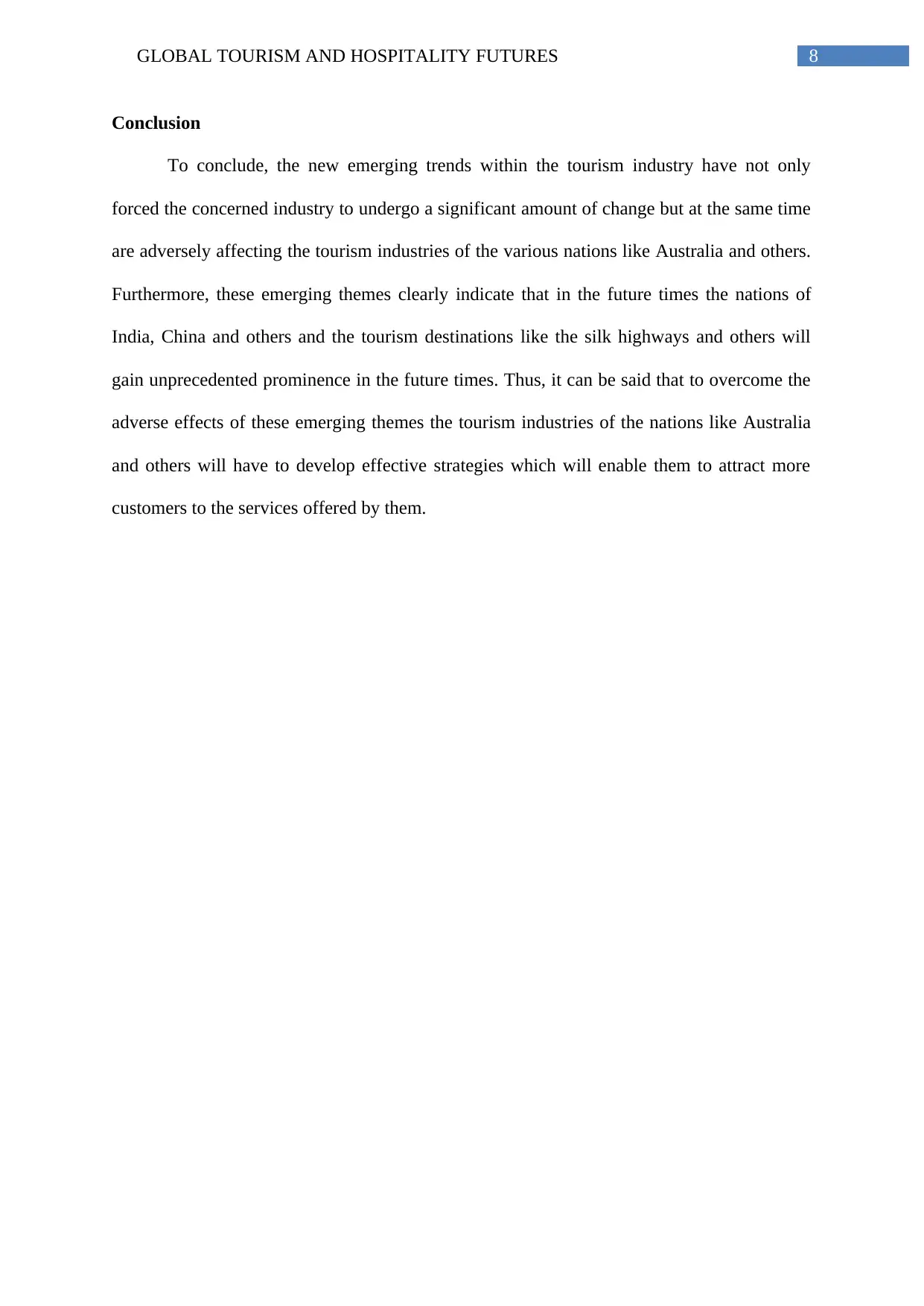
8GLOBAL TOURISM AND HOSPITALITY FUTURES
Conclusion
To conclude, the new emerging trends within the tourism industry have not only
forced the concerned industry to undergo a significant amount of change but at the same time
are adversely affecting the tourism industries of the various nations like Australia and others.
Furthermore, these emerging themes clearly indicate that in the future times the nations of
India, China and others and the tourism destinations like the silk highways and others will
gain unprecedented prominence in the future times. Thus, it can be said that to overcome the
adverse effects of these emerging themes the tourism industries of the nations like Australia
and others will have to develop effective strategies which will enable them to attract more
customers to the services offered by them.
Conclusion
To conclude, the new emerging trends within the tourism industry have not only
forced the concerned industry to undergo a significant amount of change but at the same time
are adversely affecting the tourism industries of the various nations like Australia and others.
Furthermore, these emerging themes clearly indicate that in the future times the nations of
India, China and others and the tourism destinations like the silk highways and others will
gain unprecedented prominence in the future times. Thus, it can be said that to overcome the
adverse effects of these emerging themes the tourism industries of the nations like Australia
and others will have to develop effective strategies which will enable them to attract more
customers to the services offered by them.
⊘ This is a preview!⊘
Do you want full access?
Subscribe today to unlock all pages.

Trusted by 1+ million students worldwide
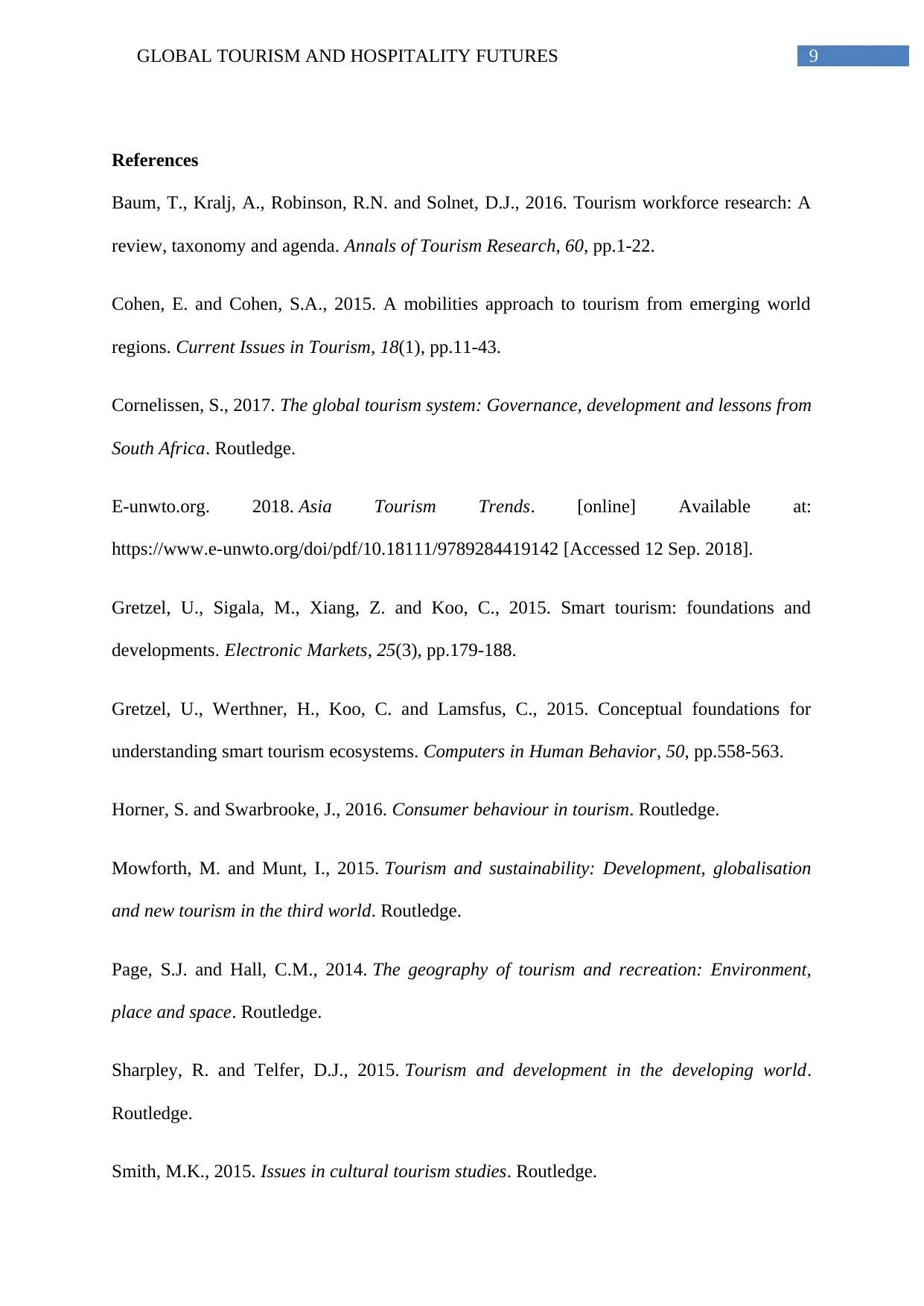
9GLOBAL TOURISM AND HOSPITALITY FUTURES
References
Baum, T., Kralj, A., Robinson, R.N. and Solnet, D.J., 2016. Tourism workforce research: A
review, taxonomy and agenda. Annals of Tourism Research, 60, pp.1-22.
Cohen, E. and Cohen, S.A., 2015. A mobilities approach to tourism from emerging world
regions. Current Issues in Tourism, 18(1), pp.11-43.
Cornelissen, S., 2017. The global tourism system: Governance, development and lessons from
South Africa. Routledge.
E-unwto.org. 2018. Asia Tourism Trends. [online] Available at:
https://www.e-unwto.org/doi/pdf/10.18111/9789284419142 [Accessed 12 Sep. 2018].
Gretzel, U., Sigala, M., Xiang, Z. and Koo, C., 2015. Smart tourism: foundations and
developments. Electronic Markets, 25(3), pp.179-188.
Gretzel, U., Werthner, H., Koo, C. and Lamsfus, C., 2015. Conceptual foundations for
understanding smart tourism ecosystems. Computers in Human Behavior, 50, pp.558-563.
Horner, S. and Swarbrooke, J., 2016. Consumer behaviour in tourism. Routledge.
Mowforth, M. and Munt, I., 2015. Tourism and sustainability: Development, globalisation
and new tourism in the third world. Routledge.
Page, S.J. and Hall, C.M., 2014. The geography of tourism and recreation: Environment,
place and space. Routledge.
Sharpley, R. and Telfer, D.J., 2015. Tourism and development in the developing world.
Routledge.
Smith, M.K., 2015. Issues in cultural tourism studies. Routledge.
References
Baum, T., Kralj, A., Robinson, R.N. and Solnet, D.J., 2016. Tourism workforce research: A
review, taxonomy and agenda. Annals of Tourism Research, 60, pp.1-22.
Cohen, E. and Cohen, S.A., 2015. A mobilities approach to tourism from emerging world
regions. Current Issues in Tourism, 18(1), pp.11-43.
Cornelissen, S., 2017. The global tourism system: Governance, development and lessons from
South Africa. Routledge.
E-unwto.org. 2018. Asia Tourism Trends. [online] Available at:
https://www.e-unwto.org/doi/pdf/10.18111/9789284419142 [Accessed 12 Sep. 2018].
Gretzel, U., Sigala, M., Xiang, Z. and Koo, C., 2015. Smart tourism: foundations and
developments. Electronic Markets, 25(3), pp.179-188.
Gretzel, U., Werthner, H., Koo, C. and Lamsfus, C., 2015. Conceptual foundations for
understanding smart tourism ecosystems. Computers in Human Behavior, 50, pp.558-563.
Horner, S. and Swarbrooke, J., 2016. Consumer behaviour in tourism. Routledge.
Mowforth, M. and Munt, I., 2015. Tourism and sustainability: Development, globalisation
and new tourism in the third world. Routledge.
Page, S.J. and Hall, C.M., 2014. The geography of tourism and recreation: Environment,
place and space. Routledge.
Sharpley, R. and Telfer, D.J., 2015. Tourism and development in the developing world.
Routledge.
Smith, M.K., 2015. Issues in cultural tourism studies. Routledge.
Paraphrase This Document
Need a fresh take? Get an instant paraphrase of this document with our AI Paraphraser
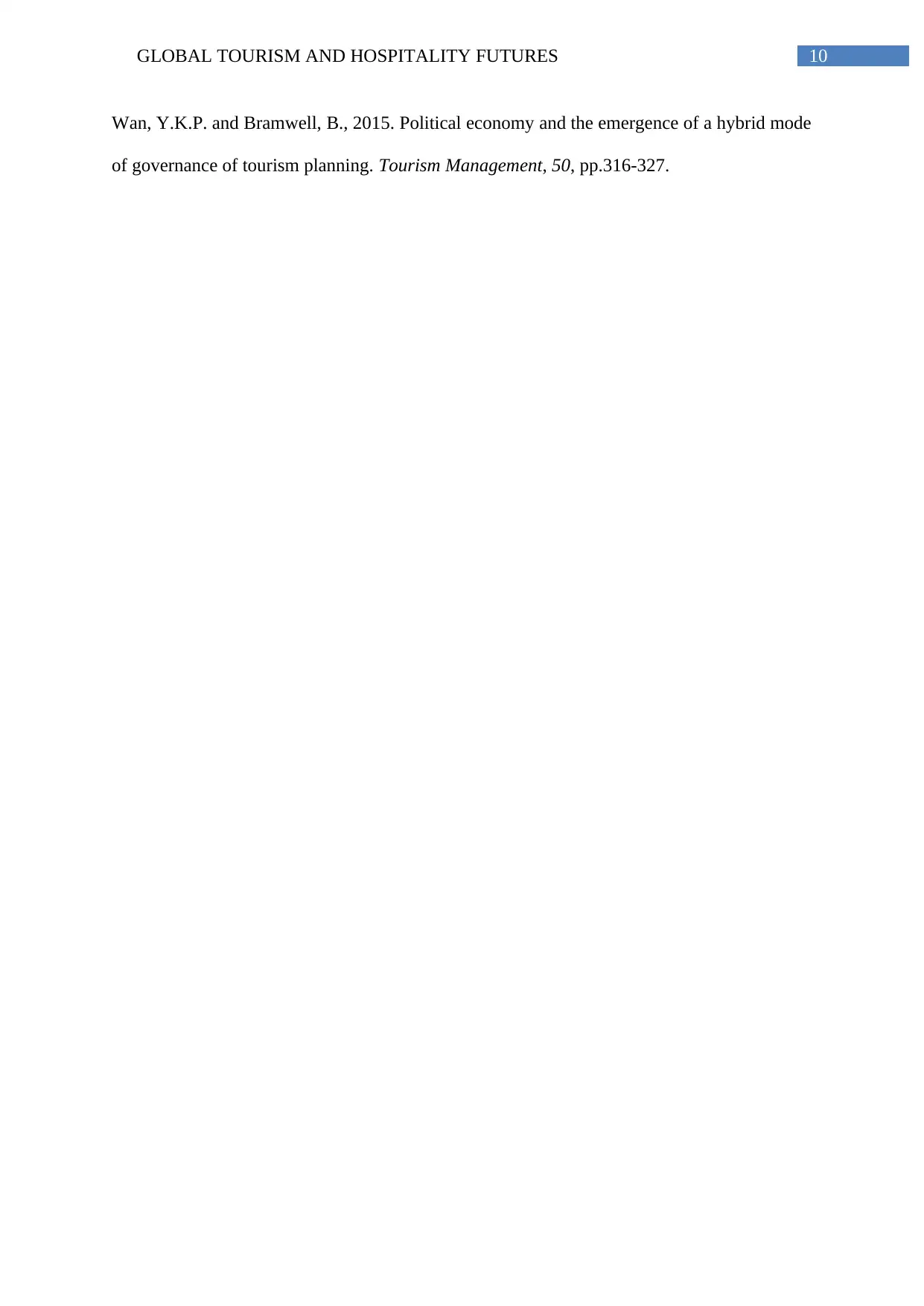
10GLOBAL TOURISM AND HOSPITALITY FUTURES
Wan, Y.K.P. and Bramwell, B., 2015. Political economy and the emergence of a hybrid mode
of governance of tourism planning. Tourism Management, 50, pp.316-327.
Wan, Y.K.P. and Bramwell, B., 2015. Political economy and the emergence of a hybrid mode
of governance of tourism planning. Tourism Management, 50, pp.316-327.
1 out of 11
Related Documents
Your All-in-One AI-Powered Toolkit for Academic Success.
+13062052269
info@desklib.com
Available 24*7 on WhatsApp / Email
![[object Object]](/_next/static/media/star-bottom.7253800d.svg)
Unlock your academic potential
Copyright © 2020–2025 A2Z Services. All Rights Reserved. Developed and managed by ZUCOL.





